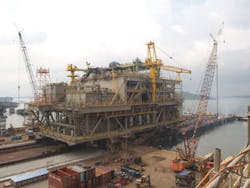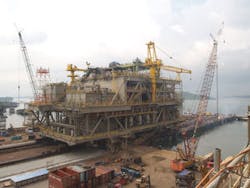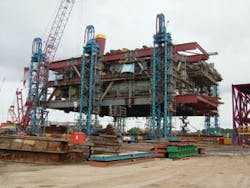Yoho topsides in delicate transfer operation
Heavy lift specialist Fagioli PSC was called on last summer to help ship out the Yoho YP platform topsides to Nigeria. Yoho operator ExxonMobil had contracted Sime Darby Engineering to build the 11,700-ton structure at its yard in Padir Gudang, Malaysia for the YP integrated production platform. This would be linked to a wellhead platform at the shallow water field.
Fagioli PSC Asia (FPSC) managed the load-out operation, which included skidding, ballasting, and de-ballasting of the transportation barge, and barge stability and longitudinal calculations. Under a separate contract, it was also responsible for lifting and assembly of the platform’s decks.
For the topsides skidding operation, FPSC used four sets of its L450 jacks. These were mounted on load-out brackets at the skid shoes and at the fixed anchors to the reaction brackets on the transportation barge. Via this arrangement, the jacks - each operating on 27 part-pulling cables -- climbed along the cables, taking the topsides with them.
The jacks/cables combination provided a safe working load of 445 ton per unit, and therefore a total pull force of 1,780 ton, equivalent to just over 15% of the topsides weight.
During break-out, maximum force was required. In this instance, all the pulling jacks were operated to their full capacity, with four 200-ton push rams added at the topsides’ rear end.
This combination provided pull capability of 2,850 ton, or just over 22% of the topsides weight. After the break-out stage, the frictional force at the contact area was lowered to around 8%, this force being catered for by the four pulling jacks.
Skidding was completed within two days. On the first day, the topsides were pulled 30 m to the quayside from their construction position. The next day, with suitable tidal conditions, the topsides were transferred onto the barge. From the quayside to the final position on the vessel, the distance covered was 140 m.
FPSC operated the skidding jacks synchronously from two sets of L4/35D power packs, giving a maximum rate of movement of around 17 m/hr during non-critical skidding. For critical crossover and/or load transfer in the area of the skid shoes, movement was reduced to around 8.5 m/hr.
The barge was ballasted and de-ballasted using a computerized ballast control system. To aid the skidding supervisor’s visibility of the pulling jacks, power packs were placed on special platforms above the jacks. Skidding of the module onto the barge took 12 hours in all, despite a pause for ballasting adjustments.
FPSC’s other assignment for this project involved lifting of the decks in readiness for mating at the yard. Yoho YP’s 740-ton upper deck was constructed in the lift location, with FPSC’s TowerLift system assembled and erected on bases alongside.
Cable lift points were connected to the top of the upper deck, which was then raised to a sufficient height to allow the main deck, mezzanine deck, and trusses to be slotted in underneath.
Subsequently, the upper deck was lowered and connected to the assembly below. The weight from the lifting system was transferred onto temporary supports, and the lifting cables re-set to the connection points on cantilevers on the main deck.
The complete assembly of decks and trusses, weighing 3,735 tons, was lifted to allow delivery and assembly of the cellar deck on the ground below. The three-deck structure and trusses were then connected to the assembly below. Finally, the FPSC team transferred the weight from the lifting system onto temporary supports to allow the TowerLift system to be dismantled.
Sakhalin test
Elsewhere, FPSC has been contracted by Samsung Heavy Industries for load-out of two giant topside decks for the Sakhalin II development. The LUN/A and PA/B decks are due to be loaded out of the yard in Korea this summer, and are expected to weigh respectively around 23,500 and 31,000 ton. FPSC expects to deploy a total of 116 of its L600 jacks for these operations, which will again be computer-controlled.
Recently completed jobs include a five-phase lifting and skidding of the utilities deck for Nexen’s Buzzard field in the UK sector of the North Sea. FPSC’s brief work involved deployment of strand jacks to aid assembly of the 7,000-ton structure at the Heerema Hartlepool yard in northern England, followed by lifting and placement onto the completed structure of three 190-ton generators.•


